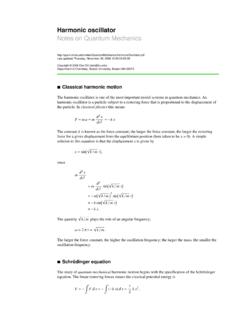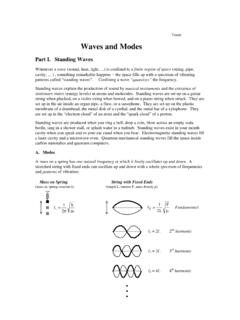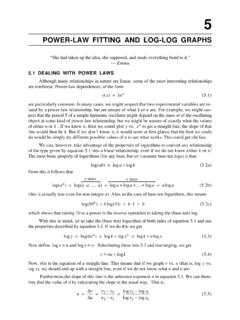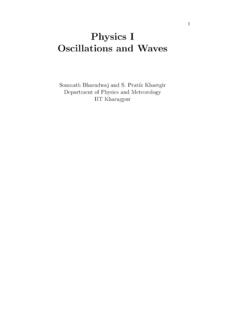Transcription of Lecture Presentation - Physics & Astronomy
1 Chapter 14 Lecture PresentationOscillations 2015 Pearson Education, 14-2 Chapter 14 OscillationsChapter Goal: To understand systems that oscillate with simple harmonic motion. 2015 Pearson Education, 14-3 Chapter 14 PreviewLooking Ahead: Motion that Repeats When the woman moves down, the springy ropes pull up. This restoring force produces an oscillation: one bounce after another. You ll see many examples of systems with restoring forces that lead to oscillatory motion. 2015 Pearson Education, 14-4 Chapter 14 PreviewLooking Ahead: Simple Harmonic Motion The sand records the motion of the oscillating pendulum. The sinusoidalshape tells us that this is simple harmonic motion. All oscillations show a similar form. You ll learn to describe and analyze oscillating systems. 2015 Pearson Education, 14-5 Chapter 14 PreviewLooking Ahead: Resonance When you make a system oscillate at its natural frequency, you can get a large amplitude.
2 We call this resonance. You ll learn how resonance of a membrane in the inner ear lets you determine the pitchof a musical note. 2015 Pearson Education, 14-6 Chapter 14 PreviewLooking Ahead 2015 Pearson Education, : p. 438 Slide 14-7 Chapter 14 PreviewLooking Back: Springs and Restoring Forces In Chapter 8, you learned that a stretched spring exerts a restoring force proportional to the stretch:Fsp= k x In this chapter, you ll see how this linear restoring force leads to an oscillation, with a frequency determined by the spring constant k. 2015 Pearson Education, 14-8 Chapter 14 PreviewStop to ThinkA hanging spring has length 10 cm. A 100 g mass is hung from the spring, stretching it to 12 cm. What will be the length of the spring if this mass is replaced by a 200 g mass?A. 14 cmB. 16 cmC. 20 cmD. 24 cm 2015 Pearson Education, 14-9 Reading Question type of function that describes simple harmonic motion isA.
3 Inverse. 2015 Pearson Education, 14-10 Reading Question type of function that describes simple harmonic motion isA. Inverse. 2015 Pearson Education, 14-11 Reading Question you displace an object from its equilibrium position and the force pushing it back toward equilibrium is _____, the resulting motion is simple harmonic SinusoidalB. ExponentialC. QuadraticD. Linear 2015 Pearson Education, 14-12 Reading Question you displace an object from its equilibrium position and the force pushing it back toward equilibrium is _____, the resulting motion is simple harmonic SinusoidalB. ExponentialC. QuadraticD. Linear 2015 Pearson Education, 14-13 Reading Question mass is bobbing up and down on a spring. If you increase the amplitude of the motion, how does this affect the time for one oscillation?A. The time The time The time does not change.
4 2015 Pearson Education, 14-14 Reading Question mass is bobbing up and down on a spring. If you increase the amplitude of the motion, how does this affect the time for one oscillation?A. The time The time The time does not change. 2015 Pearson Education, 14-15 Reading Question mass tied to the end of a string is swinging back and forth. During each swing, it moves 4 cm from its lowest point to the right, then 4 cm to the left. One complete swing takes about 2 s. If the amplitude of motion is doubled, so the mass swings 8 cm to one side and then the other, the period of the motion will beA. 2 sB. 4 sC. 6 sD. 8 s 2015 Pearson Education, 14-16 Reading Question mass tied to the end of a string is swinging back and forth. During each swing, it moves 4 cm from its lowest point to the right, then 4 cm to the left. One complete swing takes about 2 s. If the amplitude of motion is doubled, so the mass swings 8 cm to one side and then the other, the period of the motion will beA.
5 2 sB. 4 sC. 6 sD. 8 s 2015 Pearson Education, 14-17 Reading Question you drive an oscillator, it will have the largest amplitude if you drive it at its _____ SpecialB. PositiveC. ResonantD. DampedE. Pendulum 2015 Pearson Education, 14-18 Reading Question you drive an oscillator, it will have the largest amplitude if you drive it at its _____ SpecialB. PositiveC. ResonantD. DampedE. Pendulum 2015 Pearson Education, Equilibrium and Oscillation 2015 Pearson Education, 14-20 Equilibrium and Oscillation A marble that is free to roll inside a spherical bowl has an equilibrium positionat the bottom of the bowl where it will rest with no net force on it. If pushed away from equilibrium, the marble s weight leads to a net force toward the equilibrium position. This force is the restoring force. 2015 Pearson Education, 14-21 Equilibrium and Oscillation When the marble is released from the side, it does not stop at the bottom of the bowl; it rolls up and down each side of the bowl, moving through the equilibrium position.
6 This repetitive motion is called oscillation. Any oscillation is characterized by a periodand frequency. 2015 Pearson Education, 14-22 Frequency and Period For an oscillation, the time to complete one full cycle is called the period (T) of the oscillation. The number of cycles per second is called the frequency(f) of the oscillation. The units of frequency are hertz(Hz), or 1 s 1. 2015 Pearson Education, 14-23 QuickCheck mass oscillates on a horizontal spring with period T= s. What is the frequency?A. HzB. HzC. HzD. HzE. Hz 2015 Pearson Education, 14-24 QuickCheck mass oscillates on a horizontal spring with period T= s. What is the frequency?A. HzB. HzC. HzD. HzE. Hz 2015 Pearson Education, 14-25 QuickCheck mass oscillates on a horizontal spring with period T= s. If the mass is pulled to the right and then released, how long will it take for the mass to reach the leftmost point of its motion?
7 A. sB. sC. sD. sE. s 2015 Pearson Education, 14-26 QuickCheck mass oscillates on a horizontal spring with period T= s. If the mass is pulled to the right and then released, how long will it take for the mass to reach the leftmost point of its motion?A. sB. sC. sD. sE. s 2015 Pearson Education, 14-27 QuickCheck typical earthquake produces vertical oscillations of the earth. Suppose a particular quake oscillates the ground at a frequency of Hz. As the earth moves up and down, what time elapses between the highest point of the motion and the lowest point?A. 1 sB. sC. sD. 13 s 2015 Pearson Education, 14-28 QuickCheck typical earthquake produces vertical oscillations of the earth. Suppose a particular quake oscillates the ground at a frequency of Hz. As the earth moves up and down, what time elapses between the highest point of the motion and the lowest point?
8 A. 1 sB. sC. sD. 13 s 2015 Pearson Education, 14-29 Frequency and Period 2015 Pearson Education, 14-30 Example Frequency and period of a radio stationAn FM radio station broadcasts an oscillating radio wave at a frequency of 100 MHz. What is the period of the oscillation?SOLVEThe frequency f of oscillations in the radio transmitter is 100 MHz = 10 8 Hz. The period is the inverse of the frequency; hence, 2015 Pearson Education, 14-31 Oscillatory Motion The graph of an oscillatory motion has the form of a cosine function. A graph or a function that has the form of a sine or cosine function is called sinusoidal. A sinusoidal oscillation is called simple harmonic motion (SHM). 2015 Pearson Education, 14-32 Oscillatory Motion 2015 Pearson Education, : p. 440 Section Linear Restoring Forces and SHM 2015 Pearson Education, 14-34 Linear Restoring Forces and SHM If we displace a glider attached to a spring from its equilibrium position, the spring exerts a restoring force back toward equilibrium.
9 2015 Pearson Education, 14-35 Linear Restoring Forces and SHM This is a linear restoring force; the net force is toward the equilibrium position and is proportional to the distance from equilibrium. 2015 Pearson Education, 14-36 Motion of a Mass on a Spring The amplitudeAis the object s maximum displacement from equilibrium. Oscillation about an equilibrium position with a linear restoring force is always simple harmonic motion. 2015 Pearson Education, 14-37 Vertical Mass on a Spring For a hanging weight, the equilibrium position of the block is where it hangs motionless. The spring is stretched by L. 2015 Pearson Education, 14-38 Vertical Mass on a Spring The value of L is determined by solving the static-equilibrium problem. Hooke s Law says Newton s first law for the block in equilibrium is Therefore the length of the spring at the equilibrium position is 2015 Pearson Education, 14-39 Vertical Mass on a Spring When the block is above the equilibrium position, the spring is still stretchedby an amount L y.
10 The net force on the block is 2015 Pearson Education, Inc. But k L mg = 0, from Equation , so the net force on the block isSlide 14-40 Vertical Mass on a Spring The role of gravity is to determine where the equilibrium position is, but it doesn t affect the restoring force for displacement from the equilibrium position. Because it has a linear restoring force, a mass on a vertical spring oscillates with simple harmonic motion. 2015 Pearson Education, 14-41 Example ProblemA car rides on four wheels that are connected to the body of the car by springs that allow the car to move up and down as the wheels go over bumps and dips in the road. Each spring supports approximately 1/4 the mass of the vehicle. A lightweight car has a mass of 2400 lbs. When a 160 lbperson sits on the left front fender, this corner of the car dips by about . A. What is the spring constant of this spring?B. When four people of this mass are in the car, what is the oscillation frequency of the vehicle on the springs?
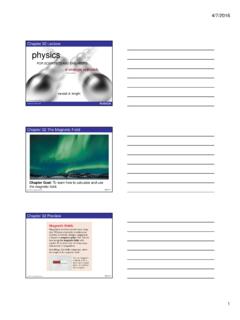




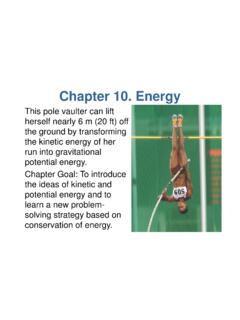
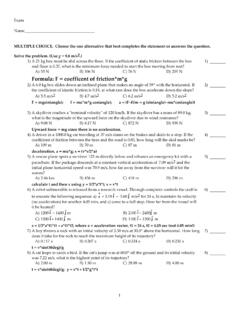

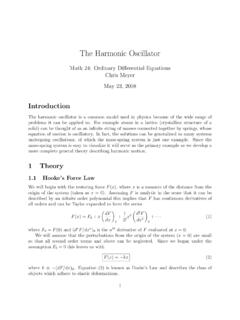

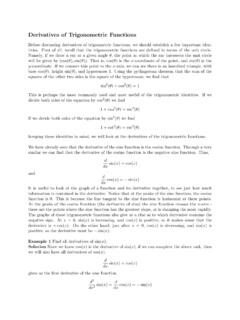
![arXiv:2112.07978v1 [quant-ph] 15 Dec 2021](/cache/preview/0/7/6/9/d/6/0/b/thumb-0769d60b3785b97adb6f78e38f482f6b.jpg)
